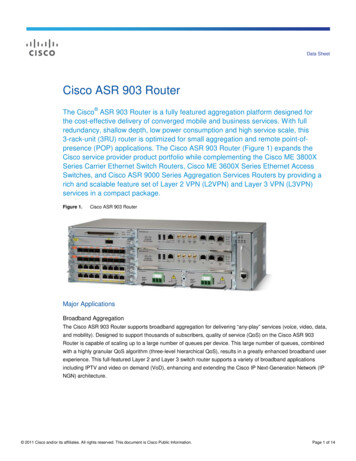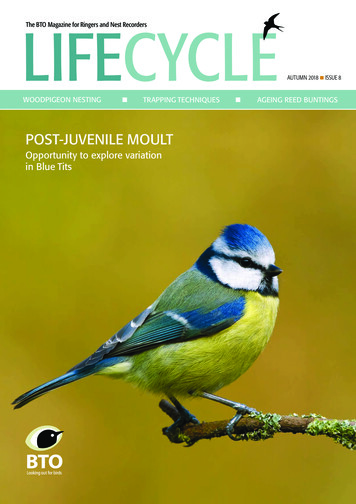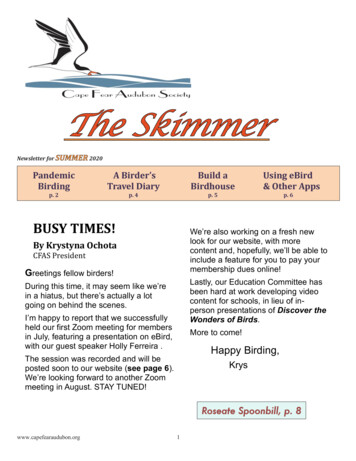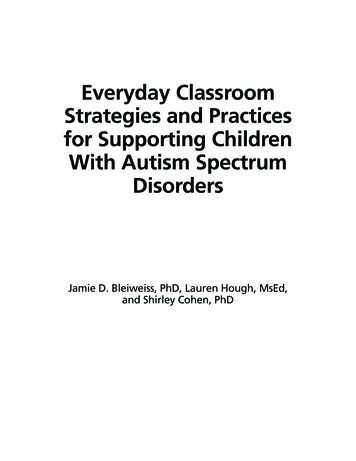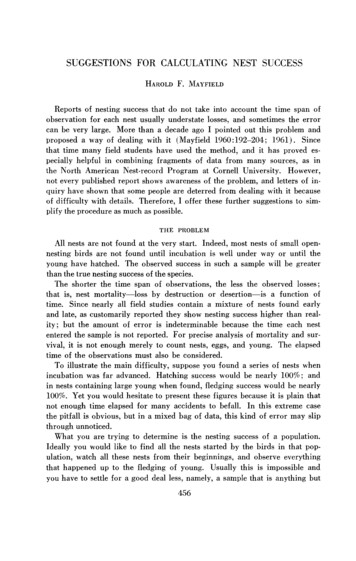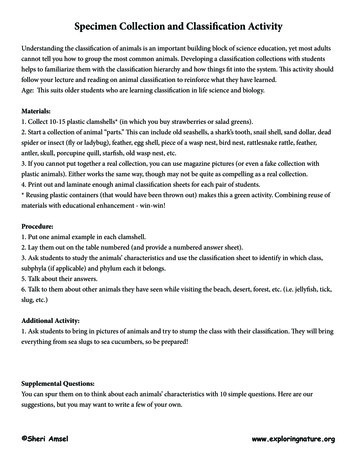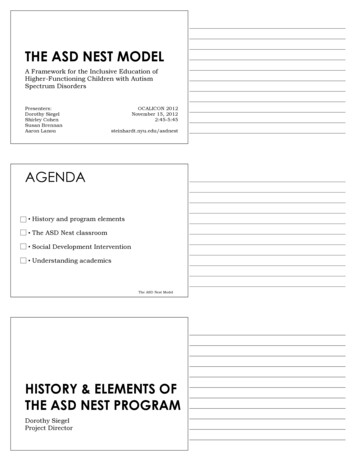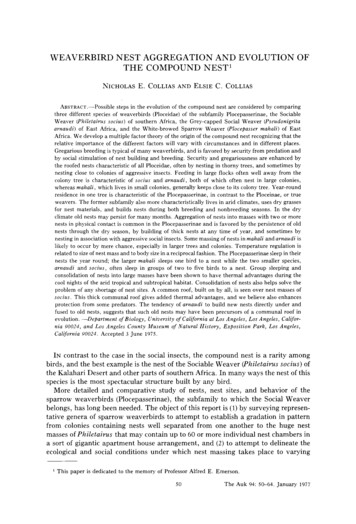
Transcription
TE. COLLIAS AND ELSIEEVOLUTIONOF1C. COLLIASABSTRACT.--Possible stepsin the evolution of the compound nest are consideredby comparingthree different speciesof weaverbirds(Ploceidae)of the subfamily Plocepasserinae,the SociableWeaver (Philetairus socius) of southern Africa, the Grey-capped Social Weaver (Pseudonigritaarnaudi) of East Africa, and the White-browed Sparrow Weaver (Plocepassermahali) of EastAfrica. We develop a multiple factor theory of the origin of the compoundnest recognizingthat therelative importance of the different factors will vary with circumstances and in different places.Gregariousbreeding is typical of many weaverbirds, and is favored by securityfrom predation andby social stimulation of nest building and breeding. Security and gregariousnessare enhancedbythe roofed nestscharacteristicof all Ploceidae,often by nestingin thorny trees, and sometimesbynesting close to coloniesof aggressiveinsects. Feeding in large flocks often well away from thecolony tree is characteristic of socius and arnaudi, both of which often nest in large colonies,whereasmahali, which lives in small colonies,generally keeps closeto its colony tree. Year-roundresidencein one tree is characteristicof the Plocepasserinae,in contrast to the Ploceinae, or trueweavers. The former subfamily also more characteristicallylives in arid climates, usesdry grassesfor nest materials, and builds nests during both breeding and nonbreeding seasons.In the dryclimate old nestsmay persistfor many months. Aggregation of nestsinto masseswith two or morenestsin physical contact is commonin the Plocepasserinaeand is favored by the persistenceof oldneststhroughthe dry season,by building of thick nestsat any time of year, and sometimesbynestingin associationwith aggressivesocialinsects.Somemassingof nestsin mahali and arnaudi islikely to occurby mere chance,especiallyin larger treesand colonies.Temperature regulationisrelated to sizeof nestmassand to body sizein a reciprocalfashion. The Plocepasserinaesleepin theirnests the year round; the larger mahali sleepsone bird to a nest while the two smaller species,arnaudi and socius, often sleep in groups of two to five birds to a nest. Group sleepingandconsolidationof nestsinto large masseshave been shown to have thermal advantagesduring thecool nights of the arid tropical and subtropicalhabitat. Consolidationof nestsalso helps solve theproblem of any shortageof nest sites.A commonroof, built on by all, is seenover nest massesofsocius. This thick communal roof gives added thermal advantages, and we believe also enhancesprotection from some predators. The tendency of arnaudi to build new nestsdirectly under andfused to old nests, suggeststhat such old nests may have been precursorsof a communal roof inevolution. Department of Biology, University of California at Los Angeles,Los Angeles,California 90024, and Los AngelesCounty Museum of Natural History, Exposition Park, Los Angeles,California 90024. Accepted 3 June 1975.IN contrast to the case in the social insects, the compound nest is a rarity amongbirds, and the best example is the nest of the SociableWeaver (Philetairus socius)ofthe Kalahari Desert and other parts of southernAfrica. In many ways the nestof thisspeciesis the most spectacularstructure built by any bird.More detailed and comparative study of nests, nest sites, and behavior of thesparrow weaverbirds (Plocepasserinae),the subfamily to which the Social Weaverbelongs,has long been needed.The object of this report is (1) by surveyingrepresentative genera of sparrow weaverbirds to attempt to establisha gradation in patternfrom colonies containing nests well separated from one another to the huge nestmassesof Philetairus that may contain up to 60 or more individual nestchambersina sort of gigantic apartment house arrangement, and (2) to attempt to delineate theecological and social conditions under which nest massing takes place to varyingThis paper is dedicatedto the memory of ProfessorAlfred E. Emerson.50The Auk 94: 50-64. January 1977
January 1977]CompoundNest Evolutiondegreesand levels of specialization.We are not in this study particularly interestedintrying to contribute evidenceto the establishmentof specificgeneologies,nor do wethink our generalobjective of seekingecologicaland social correlationswith variations in nest structure and massing is greatly dependent on knowledge of precisetaxonomies.Still, a brief discussionof the phylogenyof the Plocepasserinaeis usefulfor perspective.In 1927, after a study of skeletal material, particularly of skulls, Sushkin concludedthat Plocepasser,Pseudonigrita,andPhiletairus form a smallgroupof closelyrelated genera and united them into one subfamily, the Plocepasserinae.Chapin(1954) adopted this subfamily, and we followed his 1954 taxonomy in our monographon weaverbird nests(Collias and Collias 1964). This arrangement of generabut notthis subfamily was adopted in the "Check-list of birds of the world" (Peters 1962).Chapin helped arrange the phylogeneticsequenceof genera in the Ploceidaefor thecheck-list.In 1970 Sibley reviewed the literature on classificationof the Ploceidae, and headded some evidencebased on a study of egg-white proteins. He pointed out asimilarity in mobility of the ovalbumin fraction between Philetairus and Passer,which he tentatively groupedtogether with the the Plocepasserinaeinto a family,Passeridae.He also pointed out that as the egg-white similarity was basedon proteinmobility rather than on presenceor absenceof a distinctiveprotein, the taxonomicsignificanceof this similarity might be small. Recently Walter Bock (pers. comm.)discovereda unique skeletalelement, the preglossale,presentin the tip of the tongueof Passer, but absent, together with its associated muscle, from Sporopipes,Plocepasser,Pseudonigrita, and Philetairus. This finding tends to strengthenSuskin's original grouping of the latter three generainto one subfamily, the Plocepasserinae,and it would seemthat Philetairus is about as closelyrelated to Pseudonigrita as to any other genus.The taxonomicrelationsof Sporopipesare uncertainandrequire further study. In this report "Plocepasserinae"is used as a convenienttermfor the generaPlocepasser,Pseudonigrita, and Philetairus.The nestof Philetairus is distinctivelydifferent from that of other weavers,but onthewholeisclosestin itsstructureto thatofPseudonigritaof EastAfrica(ColliasandCollias 1964). The main differencesare in the extent of compoundingof individualnests,the presenceof a communalroof, and in the presenceof only one entrancetoeachnestchamberin Philetairus.PlocepasserandPseudonigritahave two entrancesto eachnest, exceptwhen the birds are breeding,when they plug up one entrance.This report focuseson a comparisonof the degreeof nest aggregationin thesetwogenera and in Philetairus. In East Africa we particularly studied Pseudonigritaarnaudi, the Grey-capped Social Weaver, and Plocepassermahali, the Whitebrowed Sparrow Weaver.STUDY AREAS AND METHODSPrior to the field studieson East African Plocepasserinaethat we are reportinghere, we made two briefvisits to South Africa where we had watched nests of Philetairus under nonbreedingand breedingconditions.In July 1957, the middle of the southernwinter, we visited coloniesof this bird in the WesternTransvaal, and in October 1969 we studied colonies, many of which contained nestlings,along theKuruman River and in the Kalahari Gemsbok National Park. Our visits each lasted about 12 days.In the springof 1957 in Kenya we studiedbreedingcoloniesof Pseudonigritaarnaudi and Plocepassermahali (Colliasand Collias1964).We wishedto observethesespeciesoutsidetheir breedingseason,whichnormally coincideswith the rains. During the summer of 1973, a seasonof exceptionaldrought, we
52COLLIASAND COLLIASTABLE[Auk, Vol. 941OCCURRENCEOF COLONIESOFPseudonigritaarnaudi IN RELATIONTO PLANT COVERPlant-coverindex NumberkmPercent kmGrassBush-treesurveyedwith colonies00, 1320111222231230123113256523238125472330577400 I - trace to V3, 2 /3 to 2/3,3RemarksNo grass or treesGood habitatGood habitatRather denseNo treesGood habitatGood habitatDense coverDense cover2/xto completecover.traveled some2,500 km while surveyingcoloniesofPseudonigritaarnaudi in parts of East Africa from 30June to I4 September. We also saw many coloniesofPlocepassermahali. With the exceptionof one nest ofmahali that still contained nestlingson 4 July following the breeding season,none of the many nests ofeither specieswe saw containedeggsor young, so we can take this seasonas a good example of thenonbreedingseason.We were able to confirm the fact that the birds remain permanently at the colonytrees the year round. A few individuals of each specieswere captured with mist nets and color-banded,and we were able to follow certain individuals ofmahali for a time, but the severalarnaudi we caught andbanded proved very shy at this time of year, and most were not seen again.Thesetwo speciesnestin conspicuouscoloniesin opencountry. As we drove alongthe roadswe countedall colonies within clear view, about 100 rn on each side of the road, and in many places estimated theheight of colony trees, made sample countsof the number of nestsin each colony, and their degreeofmassing,i.e. the number of nests in physical contact with another nest. We collectednestsfor lateranalysis, as well as specimensfrom the colonytrees and of the grassesin the nestsfor later identification.We also made noteson the general nature of opennessof the surrounding vegetation and documentedthevarious types of colony, of nests, and of habitats with photographs.The Ploceidaegenerally nest in colonies.For consistencywe shall use the term "colony"to mean all thenestsin onetree. If two or morenestsare in physicalcontactwe call this aggregateof nestsa "nestmass."If the nest masshas somecommunalfeature, suchas a commonroof, which may be built on by all birds,we call the nest massa "compound"nest.RESULTSFigs. 1 and 2 when compared with 3 and 4 illustrate some degree of gradationbetween the compound nest mass of Philetairus socius and the variously groupednestsof Pseudonigrita arnaudi.Relation to habitat.--Fig. 5 shows that in general colonies of arnaudi in EastAfrica occur below 5000 feet elevation (1524 m), and coincide with the semiaridacaciasavanna, i.e. areasof mixed grass,thorn bush, and thorn-trees. Coloniesweremost commonin fairly open country having intermediate degreesof grass,bush, andtree densities(Table 1). Plocepassermahali is also characteristicallyfound in aridsavanna and often nestsin the samesort of trees as doesPseudonigritaarnaudi, butits nestingcoloniesare much more likely to be found near human habitations.Relation of massing of nests to size of tree and colony.---P. arnaudi nests in avariety of trees and, in general, the larger the speciesof tree, the more nests itcontains, e.g. Acacia tortilis and A. xanthophloea, in contrast to the small A.drepanolobium and A. thomasi (Table 2). Even for the same speciesof tree thenumber of nestsis 3 to 4 times greaterin treesmore than 20 feet high than it was insmaller trees, when the speciesof treesfor which we have most data are considered.More interestingwas the fact that the averagenumber of nest massesper tree was
January 1977]CompoundNest Evolution53Fig. 1. Sideview of the roofand nestmassof aPhiletairussociuscolonyin a Camelthorntree(Acaciagiraffae), near Barberspan, Western Transvaal, South Africa, 1957.Fig. 2. Undersideof a nestmassof Philetaims sociusshowingthe many individualnestchambers,Kuruman ver,Ca ovince, South Africa, 1969.
54COLLIASAND COLLIAS[Auk, Vol. 94Fig. 3. A large colony ofPseudomgrita arnaudi in anAcacia tortills, Amboseli Game Reserve, Kenya,1973.Fig. 4. Nest ofPseudonigrita arnaudi with ten nestsin physical contact, near Hunters Lodge, Kenya,1973.
January 1977]CompoundNest EvolutionTABLE552PRINCIPAL SPECIESOF TREES USED BY NESTING COLONIESOF Pseudonigrita arnaudi IN KENYAHeight (feet)NumberSpeciesof treeNumber of nests in treeof treesAverageRangeAverageAcacia thomasi44178-304Range1 24A. senegalA. drepanolobiumA. 2-41A. tortilis73249-13301-158Balanites aegyptica192215-28142-62significantlygreater in the larger treesthan in the smaller ones(Table 3). The percentof nestsin masseswas also much greated in the larger trees, this difference beingparticularly well-marked in Acacia tortilis (the umbrella thorn), which has a large,spreading, flat-topped crown, compared with Acacia thomasi, which has a smallnarrow crown with whiplike branches.There was little or no difference in the average number of arnaudi nestsper nestmass in small and large trees, for either speciesof tree (Table 3). The situation isdifferent when we look at variability in number of nestsper nest mass, this beingmuch greater in the large colonies(Fig. 6). Of special interest are the rare casesoflarge nest masseseach composedof 6 to 12 nestsmore or lessfused together (Fig. 4)becausesuch massescome closestto the number of nest chambersin the compoundnest of Philetairus. During one breeding period of Philetairus in the Kalahari,Maclean (1973: 223) noted that the number of chambers in 22 nest massesin 14 treesranged from 4 to 50 (average 16); in the next breeding period 19 nest massescontained from 6 to 50 (average 13).Under what conditionsdo the rare instancesof large massesarise in arnaudi? Asall of them are to be found in large colonies,it would seemto somedegreea matter ofchance the more nestsin a tree the more nestswill be in physicalcontact.If it werea purely random matter, one might expect the rare instances to fit into a Poissondistribution. One of the properties of this statistical distribution is that it is determined entirely by the mean (Dixon and Massey 1969) which in this caseranged from2.3 to 2.6 (Table 3). But even assuming a Poissondistribution here, there would stillbe extremelylittle chanceof obtaining nest massesas large as six or greater (Dixonand Massey 1969: 533). Some more systematicfactor must be responsiblefor themore extreme massing. The birds show some tendency to defend their nests fromTABLE3NUMBERAND MASSINCOF NESTSOFPseudonigritaarnaudi INCREASESWITH SIZE OF TREE1Acacia thomasiRange in height (feet)Average height (feet)Numberof treesNests per tree (average)Nest massesper tree (average)Percentof nests in massesNests per mass (average)SmallLargeSmallLarge8-201621 30269-201821-40283212192710211148846224431362.4 Comparing small and large trees for A thoraasi, z - 3.2?, P1969: 116).Acacia tortilis2.30.001; for A tortilis, z2.42.62 39, P - 0.008 [Dixon and Massey
56COLLINS AND COLLIASloKitall 6ø[Auk, Vol. 9437ø o1øSAMBURUGAME RESERVE0 '0ø1ø2ø[5(5ø37 o oFig. 5. The roadssurveyedfor coloniesofPseudonigritaarnaudi, July-August 1973. Inset to lower leftshowsits general location in East Africa by dotted lines. The location of coloniesvisible from the road isshown by black bars acrossroad; coloniesclosertogetherthan 3 km road distanceare shown as continuousblack bars. Highlands above 5000 feet (1524 m) are shaded. (Map basedon Atlas of Kenya, 1962 ed.)other birds, and possiblynest massingis increasedby a tendencyof individual pairsto build new nestsnear their old nests, combined with the fact that many old nestslast from one year to the next in the dry climate the birds inhabit.If we compare the percentageof all nests in physical contact for arnaudi andmahali, we find a very similar distribution of different sizesof nest massesfor bothspecies(Fig. 7). We saw no mahali colonieswith more than 5 nestsin a mass,but wefound somearnaudi colonieswith 6, 8, 10, and 12 nestsmassedtogether. In part thisdifference is associatedwith the much greater size of some of the arnaudi coloniescomparedwith mahali colonies.Coloniesofarnaudi containedfrom 1 to 157 nestsina tree (196 colonies,average 18.6), of mahali only 3 to 32 nests(34 colonies,average13.9).Factors that help determinesize of colony---P. arnaudi coloniesare often largerthan mahali coloniesfor at least three reasons.These are differencesin (1) feedinghabits, (2) body size, and (3) sleepinghabits. In all three respectsarnaudi resemblesPhiletairus socius, as well as differing from mahali. Size of colony tree doesnot seemto be an important difference between arnaudi and mahali, and even whenmahali colonies occur in large trees there are generally many fewer nests than istrue of arnaudi colonies.Coloniesof socius are usually in large trees.
January 1977]CompoundNest Evolution2468NUMBERI020OFNESTS5740GO80 I00200IN TREEFig. 6. In coloniesofPseudonigritaarnaudithevariabilityin sizeof nestmassesis greatestin thelargertrees.A semilogarithmicscaleis usedfor sizeof colony(abscissa).70-60-Ia--a Plocepasser toohal/50z40-0z30m 20 4NUMBER6810OF NESTS PER MASSFig. 7. Percentageof nestsin differentsizedcontactgroupsis verysimilarin thetwo speciesindicated,but the sizeof nest massreachedis greater for Pseudonigrita arnaudi than for Plocepassermahali colonies.
COLLIAS AND COLLIAS58TABLE[Auk, Vol. 944Plocepassermahali SLEEPSONE BIRD TO A NEST; THE SMALLERPseudonigritaarnaudiUSUALLY SLEEPS IN GROUPSNumberPercentNumber of birds per nestofSpeciesof birdsnestsoccupied1234 to y yearsago, Friedmann (1935) in a review of bird societiesof the world notedthat birds whose reproductive area is the same as their feeding area are generallysolitary nesters,whereasthosewith spatially distinct nestingand feedinggroundsareoften colonial breeders, provided nesting places safe from predators are available.During the nonbreedingand dry season,arnaudi is often absentfrom the colonytreesduringa goodpart of the day, and may be foundin feedingflocksof 10 to 300 birdsinthe adjoining country or in more distant places in the morning and afternoon. Incontrast, the mahali we watched during the nonbreedingseasonoften fed in smallflocks or as scattered pairs or individuals close to the colony tree, usually within 50m. Like arnaudi themahali feed generallyon the ground. As Maclean (1973)showed,socius often feeds in flocks well away from the colony tree throughout the year,althoughgenerallywithin 1.5 kin. Both arnaudi and sociusalsofeed beneathor nearthe colony tree at times.The smaller body size of arnaudi meansthat a given area or amount of food cansupportmore individualsthan of the muchlargermahali. The averagebody weightof 13arnaudi we capturedin Kenya was 18.3 g, of 2 mahali 45.5 g. This differenceinbody sizehas important implicationsfor the temperature regulation and thereforeforthe sleepinghabits of the birds. In three different placeswhere we studiedarnaudiand mahali the ambient nighttime minimum temperaturesranged from 17.2øCto22.2øCat the time of our study. During the cooltropical night the small arnaudi oftenconservebody heat by sleepingin groupsof up to five or even more birds in a nest,whereasthe larger mahali sleepsingly (Table 4). In mahali coloniesmost of the nestsremain unoccupiedat night whereasin arnaudi coloniesmost of the nestsin the treeare occupied. Philetairus socius often sleeps in groups of 2 to 5 birds to a nestchamber (White et al. 1975). Group sleepingin arnaudi and sociusmeans that morebirds can be accommodatedin one tree and by a given number of nests, and is onefactor helping to accountfor the greater number of individuals in their coloniesthanwith mahali.Massing of nestsand securityfrom predators.--Other factors than size of colonymay facilitate the massingof neststogether. In northwesternTanzania where wefound the small southernrace dorsalis of Pseudonigrita arnaudi, many of the birdswere nesting in the small whistling thorn (Acacia drepanolobium), which is an antgall acacia(Dale and Greenway1961).The gallson theselittle treeswere inhabitedby coloniesof aggressiveants that instantly swarmed out and attacked us wheneverwe touched the tree in an attempt to collect a nest. These ants must furnish aneffective defensefor the birds against a number of predators. The added security tothe birds would be expected to enhance the attractiveness of ant gall acacias asnestingsites.As shownby Table 5, in 57 coloniesofarnaudi in ant gall acacias19%of the nestswere in physicalcontact, whereasnone of the nestswere massedtogetherin 81 coloniesof arnaudi nesting in the same general area in small specimensof
January 1977]CompoundNest EvolutionTABLE595M.ASSINGOF NESTS OF Pseudonigrita arnaudi dorsalis IN THE SERENGETINATIONAL PARK TANZANIA, IN SMALL ACACIATREESPercent trees withAcacia speciesAnt-galls present? Number of treesA. drepanolobiumA. senegalYesNo5781Height of treesmassed nests6-1415-2519l0 Ten trees with nestsin pairs, one tree with three nestsin mass.Acacia senegalcomparable in size to the other speciesof acacia but not having antgalls. On a previous trip to East Africa we had found an acacia crowded with antgalls and nestsof the northern race of this bird (P. a. arnaudi) in which nine nestswere in physical contact (Plate 8 in Collias and Collias 1964).We never found mahali nestingin associationwith ants, but thesebirds are muchlarger than arnaudi and their small coloniesmay engage in cooperative group defense. Thus we watched one colony cooperatein driving away a flock of woodhoopoesthat happened to pass through their colony tree. We also saw this colonydrive off two strange mahali that invaded the colony. We saw no such cooperativeattacks in the many coloniesof arnaudi we observed.Consolidation of nests of a colony into a few large massesin Philetairus.--TheSociableWeaver generally nestsin large acacia trees, such as Acacia giraffae, withstrong, heavy boughscapable of supportingthe large nest massescharacteristicofthis bird. This speciesof acacia does not occur in East Africa where Pseudonigritaarnaudi is found. For a comparable situation we took only 62 coloniesof arnaudithat were in large acacia trees of three other species(tortilis, senegal,and xanthophloea),and we found an averageof 5.7 nestmassesper tree, with 77% of the nestsin contact with other nests. We then compared thesefigures with correspondingonesfor 150 coloniesof Philetairus from a roadside survey we took alongsidethe Kuruman River southeastof the Kalahari National Park in 1969. Nest masses,besidesbeing larger, were fewer in number in a colonytree in Philetairus than in Pseudonigrita. In Philetairus as the separatemassesgrow they often fuse together. All of thenest chambers of Philetairus are consolidatedinto communal nest masses,unlike thecasein Pseudonigrita,and there were on the averageonly one or two nestmassespertree in Philetairuscolonies.Possibleorigin of the compoundroof to the nest of Philetairus.--Having the nestentrance openingdirectly downward and below the nest probably arosein evolutionbeforethe communalroof, as this entranceorientationis presenttoday in Pseudonigrita as well as in Philetairus. Quite often arnaudi builds a new nest directly beneathand broadly fused to an older nest, which could then be the precursorof a muchthickened roof in evolution.We sampled at random 52 contact pairs of nestsof arnaudi, each consistingof anold and a new nest, and in 48 of thesethe new nest was built on the same droopingbranch or twigs immediatelybelow or distal to the old nest. It is easyto distinguishthe pale brownish-yellowfresh nestswith their many projecting grassstemsfrom thedark gray old and weathered nestswith the grassends broken or flattened down onthe nest's outer surface.Use of many twigs as well as of long dry grassstemsreinforcesand strengthenstheroof of Philetairus nestsas Maclean (1973) described in the Kalahari Desert. In thisuse of twigs in the roofPhiletairus is convergentwith the buffalo weavers (Bubalor-
60COLLIASAND COLLIAS[Auk, Vol. 94nithinae), but Philetairus does not always use many twigs in the nest roof. Weencountered somePhiletairus coloniesin cultivated country in the Western Transvaal near the easternborder of the range of the species(Collias and Collias 1964). Inthis regionwhere suitabletwigs were apparently scarce,though the birds usedsometwigs, both thorny and nonthornyin the nest.roofs,they supplementedthem withmany more dry stemsof an herbaceouscompositethat grew abundantly near the nesttrees and which we were told was an introducedweed. The roof of these nest massesconsistedlargely of dry stemsor straws of various grasses(Fig. 1). Someof the twigson the roof were obviously too large for the birds to carry up (a conclusionlaterconfirmed by repeated observationof aviary housedPhiletairus) and probably justfell on the roof from overhangingbranchlets.DISCUSSIONThis discussionelaboratesa multiple factor theory of the origin of nestaggregationand of the compoundnestin the evolutionof the Ploceidaewith specialreferencetoPhiletairus and its more immediate relatives in the Plocepasserinae.We will discusseach factor as it relatesto other factors in an attempt to delineate the role of eachfactor of evolution in an interacting system. Also by studying casesof convergentevolution, as between the sparrow weavers (Plocepasserinae)and the true weavers(Ploceinae)or other birds, we shouldgain someidea of the mostfavorable conditionsfor the origin of nest aggregationand of the compound nest.Maclean (1973) suggestedfor Philetairus socius that "a paucity of trees such asoccursover most of its range today would have favored the evolutionof a communalnest so as to fit as many pairs as possibleinto the limited number of available nestsites." He noted in the Kalahari that where there was only one tree per mile that hejudged to be suitablefor nestingby Philetairus, it was almost sure to be occupied.But as the number of trees increasedup to 49 trees per mile the percentageoccupation by the birds fell to less than 3%.Generally Philetairus coloniesare to be found in large trees, but Pseudonigritaarnaudi nestsin a wide range of tree sizes.In other words the range of choicesofsuitablenestsitesavailable to this speciesis so wide that it seemsmuch lesslikely tosufferfrom a shortageof nestsitesthan isPhiletairus. Placesthat might conceivablyhave a shortageof potential nestsiteswould be expectedto favor crowdingof thebirds into the few sites available.As shown by the resultsof this report, large size of a colonyin arnaudi increasesthe probability of physicalcontactbetween nests.In turn, increasein colonysize isfavored by nestingin large trees, by sleepingmore than one bird to a nest, and byotherwise favorable conditionsof food supply and nesting materials.Socialstimulationmay help stimulatemore nestbuilding and breedingthan takesplace in very small coloniesof the samespecies,especiallyby extendingthe breedingseasonas has been shownexperimentallyfor the Village Weaver, Ploceuscucullatus(Collias et al. 1971). Deserted coloniesofPseudonigrita arnaudi are likely to be verysmall, and may have lacked sufficient social stimulus to keep growing, althoughother unknown causesmay terminate a colony. In the Amboseli Game Reserve wesaw 26 suchcolonies,mostlyinAcacia tortills, in which all the nestswere dark gray,old, and faded, with an averageof only 4 to 5 nestsper tree. Althoughthe Plocepasserinae may build neststhe year round at their colony sites, the relationship of social
January 1977]CompoundNest Evolution61stimulationto gregariousbreedingand to rate of nestbuilding in this subfamilyhas ßnot been investigated.A generaland importantdifferencebetweenthe Plocepasserinaeand the Ploceinaeis the permanentresidenceof the former in the colonytrees.Year-round occupancyof the nestingtree by the sparrowweaversat leastfor sleepingin the nestsis favoredby the arid climate they inhabit and the use of dry grassesfor nest materials. Oldnestshave thick walls and sturdy constructionand in a dry climate may last formonthsand from onebreedingperiodto the next.Plocepasser,Pseudonigrita,andPhiletairus may build new nestsonto old nestsin the same tree from year to year.In the true weaversor Ploceinae,parallel evolutionwith the Plocepasserinaehasresultedin the considerablemassingof nestsseen, for example, in the large coloniesof the Chestnut Weaver (Ploceusrubiginosus)(Collias and Collias 1964). Physicalcontact of nests is also very common in the crowded colonies of Speke's Weaver(Ploceusspekei). In an active colony of this speciessome 14 km north of Nakuru,Kenya, 24 nestswere in physicalcontact with at least one other nestand 24 were not.Both species,like the Plocepasserinae,often inhabit semiarid or arid savanna. Ingeneral,the Ploceinae,unlike the Plocepasserinae,deserttheir nestingtreesin thedry season,so one can concludethat permanentresidenceis not a requirementfornest massing, although it enhancesthe tendency to massing.The advantage of nest massing to thermal regulation confers a benefit and apositive selectionpressurethat may have led to increasingconsolidationof nestsinevolution.White et al. (1975)found in Philetairus sociusin the Kalahari that a largenest massheatsup from the sun more slowly during the day than a small massandlosesheat more slowly at night. Group sleepingin the nest chambershelpsadd heatto the nest massduring the cold winter nightsof the Kalahari when the temperaturemay fall to freezing or even lower. Any thermal advantagesof consolidationof nestsin the Plocepasserinaeis reinforced by other positive selectionpressures,as consolidation also helps relieve the problem of shortageof nest sitesin suitable trees.Increasedsecurityfrom predatorsmay permit colonialbreedingand nest massingirrespective of the nature of the agency enhancing security, whether it be thorns,ants, bees, wasps, or hawks, eagles,or vultures nestingin the sametree with theweaverbirds (Collias and Collias 1964). In a review of bird-insect nesting associationsMoreau (1936) showed that a number of speciesof weavers and other birds buildalongsidenestsof aculeateHymenoptera in Africa and Asia, as do someicterids inAmerica. In Nigeria, McLaren (1950) noted that nests o
between the compound nest mass of Philetairus socius and the variously grouped nests of Pseudonigrita arnaudi. Relation to habitat.--Fig. 5 shows that in general colonies of arnaudi in East Africa occur below 5000 feet elevation (1524 m), and coincide with the semiarid acacia savanna, i.e. areas of mixed grass, thorn bush, and thorn-trees. .
